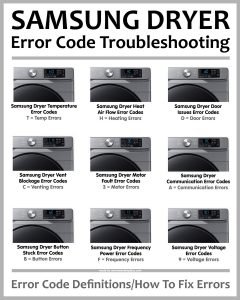
The “OE” error code isn’t something out of a sci-fi movie. It stands for a problem with the dryer’s *output exhaust*, which is essentially the path that hot, moist air takes to exit your machine. Think of it like how smoke needs a chimney to leave a fireplace. If that path is blocked, the heat and moisture can’t escape, and your dryer can’t do its job. This is more common than you might think, but it’s a problem you can solve with a bit of elbow grease and patience.
Understanding the “OE” Error Code
To really get to the heart of the “OE” error, we need to understand what your dryer is trying to tell you. The *output exhaust* is where all that moist air from your clothes goes. If it’s obstructed, things can back up, just like when a river is dammed. When your Samsung dryer displays this code, it’s essentially saying, “Hey! I can’t breathe!”
The main job of the exhaust system in a dryer is to vent out the humid air efficiently. If there’s any blockage, lint or even a kinked duct, this doesn’t happen as it should. This error is essentially a way your smart dryer is looking out for itself—and you—by preventing overheating and potential damage.
So, why is this important? A blocked exhaust means your clothes won’t dry as effectively, and in the long run, it can cause wear and tear on your dryer. It’s a bit like driving a car with blocked exhaust pipes—the engine struggles, performance drops, and it’s just not good for the vehicle. The solution? Stay vigilant about keeping that exhaust clear.
Common Causes of the “OE” Error Code
Now that we know what the “OE” error is, let’s talk about why it might happen. One of the most straightforward causes is a *clogged vent*. Lint is the usual suspect here. Over time, it accumulates in the exhaust duct, like plaque in arteries, restricting the airflow. This is why it’s crucial to regularly clean the lint filter after every load.
Another sneaky cause could be the *vent hose*. If it’s squashed or twisted, the air can’t flow smoothly. Imagine trying to sip a milkshake through a bent straw—it’s not going to go well, right? The same thing happens when your dryer’s hose is not straight and clear. You might even discover a small bird or critter has decided to set up home in the external vent, blocking it completely.
Finally, consider the *dryer location*. If your dryer is crammed into a tight space, it might just not have the room it needs for proper ventilation. This limitation can also lead to an OE error because the hot air can’t escape the confines of a narrow area.
Resolving the “OE” Error Code
So, you’ve got an “OE” error, and it’s time to roll up your sleeves. The first step? Check the *lint filter*. It’s such a simple fix and yet so often the culprit. Pull out the filter, give it a thorough clean, and see if that clears the error.
Next, you’ll want to inspect the *vent hose*. Ensure it’s not bent or crushed and that it’s securely attached to both the dryer and the wall. If the hose is damaged, it might be time for a replacement. It’s quite similar to changing a garden hose—if it’s full of kinks and leaks, it’s just not going to work well.
If these solutions don’t solve the error, take a look at the *external exhaust outlet*. A flashlight and a peek outside should help you see if anything is obstructing it. If you find a nest or a cluster of leaves causing a blockage, carefully clearing it should do the trick.
Maintaining Your Dryer to Prevent Future Errors
The best plan is a prevention plan, right? To avoid running into the “OE” issue again, make regular maintenance part of your laundry routine. Think of it like brushing your teeth—frequent care prevents bigger problems.
Start with the *lint filter*. Make it a habit to clean it after every use. It’s a small step but significantly reduces the chance of clogs in the exhaust path. This is the simplest way to keep your dryer running efficiently, just like changing the oil keeps a car engine happy.
Next, regularly inspect your *vent hose*. Ensure it’s straight and in good condition. It’s worth checking the external duct a few times a year, too, especially if you’re in an area where critters or heavy winds might cause blockages.
Lastly, consider the placement of your dryer. Make sure there’s enough space around it for proper ventilation. Think of it as giving your dryer room to breathe—suffocating it in a tight space can lead to more frequent issues.
By following these steps, not only will you keep that pesky “OE” error at bay, but you’ll also extend the life of your dryer and improve its efficiency. Remember, a little maintenance can go a long way!